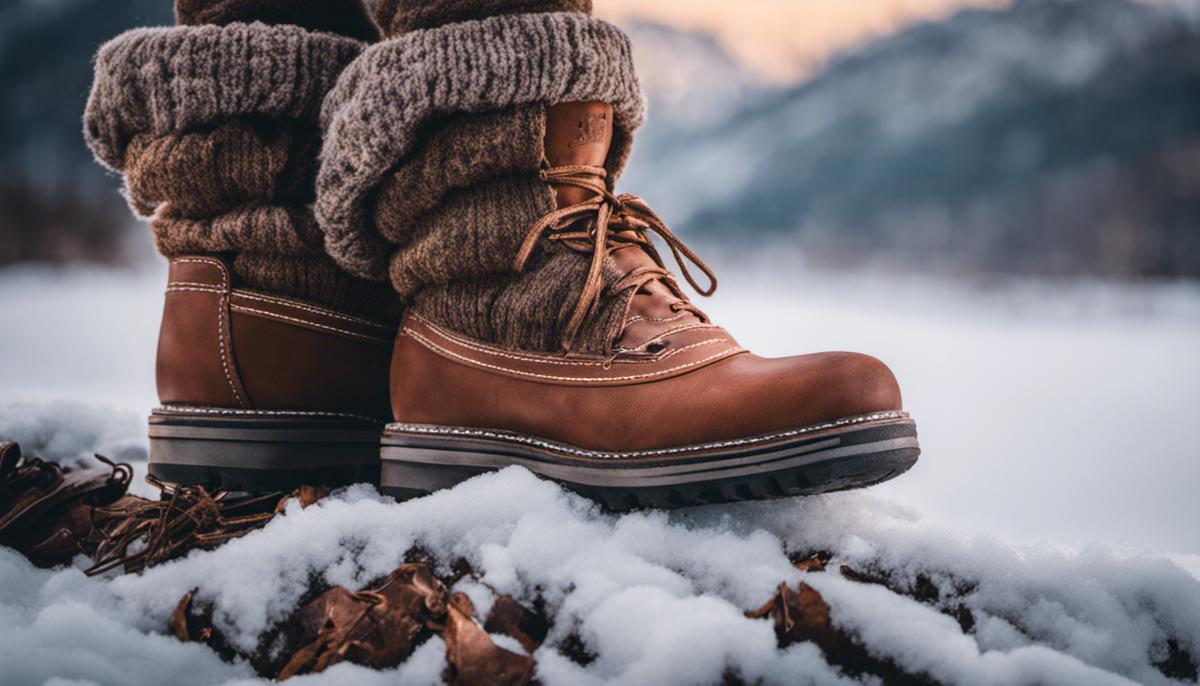The presence of an icy chill, towering snowdrifts, and shorter days are part and parcel of a typical Canadian winter. Living through and even thriving in this unyielding season requires a keen understanding of how to stay warm and comfortable. This formula consists of more than merely loading up on heavy clothes; it’s an art that encompasses knowing the ideal materials to wear, understanding temperature regulation through layering clothing, and protecting your extremities with quality winter gear. Furthermore, going beyond your personal wardrobe, a weatherproof house plays a crucial role in providing a comfortable refuge from the bone-rattling cold. Lastly, being mindful of your mental and physical well-being during these potentially harsh months can prevent complications such as winter blues, dehydration, and dry skin, helping you enjoy a healthy winter season.
Table of Contents
Dressing Properly
Building a Winter Wardrobe Fit for Canadian Winters
When winter’s icy fingers start to brush across Canada, every family instinctively knows it’s time to layer up family members with all the warmth we can muster. Navigating a Canadian winter is an adventure and keeping your family warm and cozy is a key part of the journey. Dressing appropriately for the cold makes it possible to cherish every frosty moment comfortably. Warm clothing doesn’t just enable play in the great outdoors, it creates room for lasting family memories.
So, what does “dressing appropriately ” imply? The answer isn’t merely bundling up in layers; it involves a thoughtful process to find the right balance between comfort, protection, and mobility. In this article, we’ll walk you through practical tips to help your family prepare for a Canadian winter, one outfit at a time.
- Start with The Base Layer
- Insulate with The Mid Layer
- Protect with The Outer Layer
- Heads, Hands, and Feet
- A Note on Material Choices
- Consider the Details
This step is all about regulating body temperature. Opt for moisture-wicking fabrics for the base layer—think long underwear and fitted tops. These help in drawing moisture away from the body and keeping your loved ones dry and warm. Look for materials like synthetic polyester or natural fibers such as merino wool, silk, or bamboo.
The purpose of the mid-layer is to trap heat close to the body and can be as simple as a regular sweater, hoodie, or vest. Fleece is a dependable choice due to its lightweight and soft texture. Quilted down jackets, wool sweaters, or even a pullover can do the trick. Remember, insulating doesn’t mean packing on bulky clothes—rather, choose pieces that balance warmth and comfort.
Canadian winters demand all-family respect for the outerwear game. It’s not enough to look chic; one has to think about function first. Your outermost layer should be a waterproof and windproof shell jacket or a lined winter coat that can fend off snow, rain, and wind. Opt for jackets with thicker filling or lining for colder locales or days with lower temperatures.
To beat the chill, paying attention to extremities is crucial. Invest in thermal socks to keep your family’s feet warm. Look for mittens rather than gloves—they tend to be warmer because fingers maintain their warmth when not separated. As for your family’s heads, fuzzy hats or beanie caps with ear flaps are a must. These accessories aren’t mere fashion statements but essential tools for surviving Canadian winters.
When it comes to beating the cold, not all materials are created equal. Wool, down, and fur are natural insulators and resist moisture. On the other hand, synthetic materials like Gore-Tex, Thinsulate and PrimaLoft provide superior waterproofing and windproofing while remaining lightweight and breathable. The best winter wardrobe pieces, however, often find a way to incorporate both natural and synthetic materials.
Invest energy in details too, like waterproof zippers, adjustable cuffs, and collars. Smaller additions, such as built-in gaiters and drawstrings, significantly prevent cold air from entering. Arranging outfits with these thoughtful details in mind ensures higher quality protection.
Remember, the right clothes can turn any white, icy Canadian winter day into an exciting expedition waiting to happen. Here’s to creating and capturing unforgettable winter memories in your perfectly suited-up family! Stay warm and comfortable, and embrace each moment that the season of snow brings.

Weatherproofing Your Home
Getting Your Home Ready for the Freezing Canadian Winters
With every changing season, comes a new set of challenges. When the harsh Canadian winter edges in, it’s not only crucial to keep yourself warm, but it’s equally essential to prepare your home for the plunging temperatures.
- Winter-Proof Your Windows
Your windows could be massive energy drains during winter, making rooms draughty and chilly, allowing the warm air to escape and cold air to squeeze in. Hence, consider winter-proofing your windows by replacing them with double-pane windows. If this isn’t an option, consider using weather-stripping or window film as a cost-effective alternative to minimize heat loss from your windows.
- Insulate The Roof and Attic
The goal during winter is to keep as much heat indoors as possible while blocking the icy chilling winds from intruding. The roof and attic can function as shields for your home during winter. Ensure your roof is in a sturdy condition and patch up any leaks. If your home is older, consider adding extra insulation to your attic, which could notably reduce the cold inside your home.
- Check Your Furnace
Your heating system – whether furnace or boiler – is a critical component for surviving the harsh winters. To ensure it’s up to the task, perform routine maintenance well before winter strikes. You might consider hiring a professional to conduct an inspection and clean the ducts to ensure the heat circulates through your home effectively.
- Prepare Your Pipes
Another potential hazard of freezing temperatures is the threat of pipes bursting due to frozen water inside. Make sure to insulate your water pipes, especially those running along the exterior of your home. For additional protection, allow faucets to drip slowly on those particularly cold nights, which keeps water flowing and helps to prevent pipes from freezing.
- Use Draft Stoppers
Doors tend to have gaps that allow frigid air to seep in. A simple and cost-friendly solution is sealing these gaps by placing draft stoppers which act as barriers against the cold.
- Safeguard Your Outdoor Space
Your backyard or patio needs some attention too. Winterize your outdoor furniture by either bringing it indoors or properly covering it to protect from the unforgiving snow. Make sure to prepare your garden for the incoming freeze – perennials should be trimmed back and delicate plants and shrubs covered for protection.
- Stock Up On Essentials
Lastly, brace for snowstorms or other extreme weather events by stocking your pantry with food that doesn’t require electricity to prepare, keeping a pile of firewood if you have a fireplace, and maintaining an adequate supply of blankets for extra warmth.
While arming yourself with an effective layering system is important to withstand the freezing winter outside, it’s equally crucial to prepare your home. Use these handy tips to develop your winter-preparation checklist and make your home a cozy haven against the cold. After all, there’s no warmer feeling than enjoying a hot cup of cocoa by the fireplace – safely inside your toasty, winter-ready home.

Winter Wellness
Sustaining A Healthy Lifestyle During Harsh Canadian Winters
Canadian winters, known for their freezing temperatures and heavy snowfall, can be quite demanding. Here are some helpful ways of ensuring personal wellness, warmth, and a positive mindset during these icy months.
- Nutritional Balance: A well-balanced diet is critical for maintaining energy levels and fortifying the immune system during winter. Nutrient-rich foods including fruits, vegetables, lean proteins, whole grains, and low-fat dairy products can provide the necessary vitamins and minerals your body needs. Including vitamin D supplements can also make up for the lack of natural sunlight.
- Regular Exercise: While cozying up indoors seems tempting, keeping active is paramount. Whether it’s indoor workouts, yoga, home-based strength training, or braving the snow for a brisk walk or sledding, keeping the body in motion helps to promote better circulation, strength and overall wellness.
- Mental Health Awareness: The lack of sunlight and confining temperatures can lead to Seasonal Affective Disorder (SAD), a type of depression that occurs during the winter months. Ensuring you’re getting enough sunlight, practicing relaxation techniques such as mindfulness or meditation, and seeking professional help if necessary, are beneficial for maintaining mental wellbeing.
- Dealing with Dryness: The winter season can lead to dry skin and hair. Keep them moisturized to prevent cracks, itchiness, and other discomforts. The use of humidifiers can also maintain the moisture balance in your home’s air, helping to relieve dry skin and respiratory issues.
- Socialization: Though it might seem challenging, remaining social during the winter months is crucial for mental wellness. From virtual hangouts, book clubs, family game nights to winter BBQs, these activities can boost your spirits and build stronger relationships.
- Safety Measures: While embracing the winter season, it’s important to keep safety paramount. Keeping driveways and sidewalks ice free, equipping vehicles with winter tires, and having a first-aid kit handy are imperative.
- Learning A New Skill: Winter can be a perfect time to learn something new. Whether it’s cooking a unique recipe, knitting, or trying out a new board game, these activities can keep the mind active and engaged.
- Adequate Rest: Finally, make sure to get plenty of rest. Sleep boosts the immune system and helps to fight off the winter blues.
By implementing these practices, one can maintain wellbeing during the frigid Canadian winters. Remember, winter is not just about survival but also about embracing its beauty and creating lifetime memories with loved ones. Stay warm, healthy, and positive during these months. Embrace the season!

Weathering a Canadian winter comfortably and safely requires the right combination of well-chosen attire, an optimally insulated home, and mindful wellness strategies. Incorporating high-quality warm clothing materials, perfecting your layering techniques, and shielding your extremities can make all the difference in your daily comfort levels. Concurrently, properly insulating your home, auditing your heating system, and taking preventative measures against freezing pipes can contribute towards maintaining cozy indoor warmth. In addition to these physical preparations, caring for your own well-being is imperative – from staying well-hydrated and adequately moisturized to combating wintertime emotional challenges and managing Vitamin D levels. By following these guidelines, not only can you stay warm throughout the season, but you can also truly embrace the majestic beauty that a Canadian winter has to offer.

Zara Desertrose is an acclaimed fashion and lifestyle journalist with a Master’s in Fashion and Luxury Marketing. Known for her keen eye for style and cultural trends, Zara’s writing elegantly weaves together the latest fashion movements with lifestyle aesthetics. Her insightful critiques and trend forecasts make her a leading voice for anyone looking to stay at the vanguard of style.

